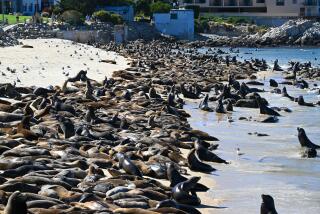Transplanting Sea Otters to San Nicolas Island
- Share via
Once again human beings are trying to rectify another of their mistakes in dealing with the animal world by committing an even graver error. I refer to your editorial (June 10), “Another Home for the Sea Otter,” which stated the benefits of transplanting “one of nature’s most appealing creatures,” the sea otters, to nearby San Nicolas Island.
The phrase in quotes says it all; namely, our typically preferential and perverse protection of one “cute” species at the expense of the “balance in nature” we should maintain for the protection of all existing species, including ourselves.
It’s true we humans decimated the ranks of the sea otter in the 19th Century, but what the editorial fails to point out is that in doing so, we also wiped out the natural predators of the sea otter by taking away their food supply. In other words, we eliminated the natural means by which seat otter numbers could be kept in check.
Sea otters increase rapidly. Voracious feeders, they must ingest an amount equal to their body weight (60 to 70 pounds) every three to four days. We’re talking about abalone, lobster, clams, crab, fish, sea urchins and whatever else they want. The editorial stated it plainly: “Within five years the shellfish catch at San Nicolas Island could be eliminated.” And then where do these hungry and appealing creatures go? They migrate to the other islands nearby and finally to our Southern California coast.
If anyone thinks, given the limited budget and resources of the Fish and Game Department, that these animals can be stopped once they begin migrating to new feeding territories, they’re wrong. By then it would probably be too late to do anything about it and the entire Southern California shellfishing industry, as well as sport fishing interests, could be wiped out. That’s not even considering the harm to the shellfish species themselves. Sea otters don’t pay attention to Fish and Game size restrictions, which allow shellfish to reproduce. They will eat the animals at any size, virtually wiping out their own food source.
What’s most ironic is how unnecessary the plan really is. Since the proposal was conceived in 1971, 16 years ago, the sea otters’ population and range have increased dramatically in California. When you take into account that these otters number over 160,000 in Alaskan waters, you wonder why we would take such a chance with our own food source.
It’s pathetic to realize that many of the sea otters’ so-called protectors are no more than “armchair naturalists” who get no closer to nature than their TV sets and don’t seem to understand that the “not-so-cute” creatures, like shellfish, could use a little protection as well.
JIM PRIMROSE
Rancho Cucamonga






